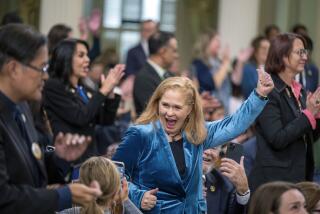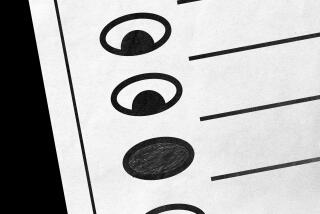In California, Politicians Choose--and Voters Lose
- Share via
SACRAMENTO — What if the World Series had been played during spring training, the commissioner of baseball having picked the competing teams? Baseball fans would be outraged. Yet something similar has happened to California elections. In the vast majority of legislative and congressional districts, we have no general election contests this fall because the races were decided in the spring primaries. The political stadium is dark.
How many competitive races for the House of Representatives are there in the Southland? None. How many competitive races for the state Senate? None. How many for the Assembly? Two--at most.
According to the California Target Book, which analyzes congressional and legislative races in the state, there are nine hotly competitive elections this fall out of 153 districts. There are another nine potential contests if the challenger can raise sufficient funds. Put another way, in only 18 of California’s 153 districts--12% of the state--will voters have a choice on who represents them in the Legislature and Congress.
How did California end up with this system of representation without elections?
California legislative politics are a three-legged stool: term limits, gerrymandered districts and the closed primary. While term limits have eviscerated seniority and institutional memory in the Legislature, they have produced turnover, which explains their strong public support. Every attempt to overturn or modify term limits has failed, including a ploy during the spring primaries to keep the last of the pre-term-limits legislators in office a little longer.
The public seems to understand that only because of term limits does it have any choice at all, since every cycle one-third of the Assembly and one-quarter of the Senate are termed out. Term limits at least allow political choice; the other two legs of California politics restrict it.
Gerrymandered districts especially restrict voter choice. Redistricting, which occurred in 2001, is a process whereby the politicians choose the voters. The fall elections will be the first using the new political maps, and they were drawn with great care to segregate voters so that almost every seat is safe for the incumbent party. We have a “bipartisan apartheid” in legislative and congressional districts: Democrats are in Democratic districts, Republicans are in Republican ones.
As a consequence, virtually every district, even those that term limits open up, was decided in the spring primaries. Only a handful were not decided in March, and it’s not that the map makers didn’t try to make them safe too. Seven of the nine hotly contested legislative and congressional districts are in California’s Central Valley, running roughly from Bakersfield to Stockton (four of the seven seats include parts of the city of Stockton). Although they hacked up Stockton, the map drawers could not find enough safe territory to make all the districts safe.
So, we have the absurd situation in which Stockton, a city of 244,000, is the last, best hope for electoral democracy in California, with more political contests for Congress and the Legislature in the general election than all of Southern California.
That’s why the primary was so important: Real decisions were made. Term limits forced out 31 Assembly members and seven senators. One more district opened up when Assemblyman Phil Wyman (R-Tehachapi) lost his primary. But according to the California Target Book, all but nine winners were decided in the primary. Essentially, we have had a shadow Legislature waiting since last March to take office, with 30 new legislators awaiting pro-forma election in November.
They were elected at a primary with few voters participating. Only 34.6% of registered voters cast ballots last March, the lowest election turnout in California’s history. That amounted to 5.2 million of the 15.3 million registered to vote and the 21.5 million people eligible to vote.
That brings us to the third leg of the state’s political stool, the closed primary. Thanks to a U.S. Supreme Court decision throwing out California’s former open-primary law, the March elections were once again limited to registered partisans (and the small number of decline-to-state voters who asked for a partisan ballot).
If redistricting is the process whereby politicians choose the voters, a closed primary is the process whereby unwanted voters are weeded out. Combine gerrymandered districts with the closed-primary system and a legislator never has to worry about any voters other than his or her most solid partisans. They are the people who vote in primary elections.
Fewer than half the voters could participate in many primary elections. Voters not registered with the dominant party in a safe district cannot participate in that party’s primary election. That means candidates need only campaign to their own die-hard partisans.
That’s what a politician likes--the fewer voters, the better, and especially if they are the most partisan ones. Candidates beat their breasts about what hard-core partisans they are, and the tiny number of people who go to the polls respond by electing the most hard-core partisans in both parties.
The result is a largely dysfunctional Legislature. Members chosen in a closed primary, with a minimum of voters participating, come to Sacramento intent on representing the narrow partisan positions that got them there.
Is it any wonder they cannot negotiate a state budget? Passing the budget--it was two months late this year--is the most important and most difficult thing a legislator does because it requires compromise and negotiation. The current system encourages exactly the opposite.
One Republican who might have broken the budget impasse this summer privately told friends, “Look, I can’t afford to cross my primary voters; they demand that I hang tough.” The sentiment was the same on the Democratic side. A look at the shadow Legislature elected in March shows future members will be even more ideologically rigid.
Californians might remember this when they cast their meaningless votes in November for their preordained members of the Legislature--if they bother to vote at all.
More to Read
Get the L.A. Times Politics newsletter
Deeply reported insights into legislation, politics and policy from Sacramento, Washington and beyond. In your inbox three times per week.
You may occasionally receive promotional content from the Los Angeles Times.










